David Traub met with Jen Webb in Whanganui on 26 June 2012 to discuss David’s work and the relationship between art and the everyday.
On process and judgment
Jen: In the 15 or so years I’ve known you, you have made baskets, sceptres, platters, two-dimensional works, three-dimensional works, sculptures … When you’re working on an idea, it seems, you stay with it for quite a while.
David: Well, I’ve been working within the platter form now for right on 10 years, but I think I am still stretching the boundaries of what I can do with that form, so I’m quite happy to keep playing with it.
Jen: When I was here last year for the Glass Festival, you showed me a still life you were working on. It was a collection of standard domestic vessels that you had cut in half, and you were attaching them to a surface. Did you go anywhere with that work?
David: No, I went off in another direction. But I’m currently working on three still lifes, which I have to finish in the next fortnight for a show on Waiheke Island. The title of the show is Form Versus Function, because none of the work is functional. I’m looking at the domestic vessel in two different formats—two-dimensional and three-dimensional; and I’m going to show five pieces from the Illusion series, and five from the Still Lifes series. The Still Lifes are glued to a piece of glass, so you can’t pick up them up individually, and in the Illusion series, the pieces are two-dimensional representations of three-dimensional objects.
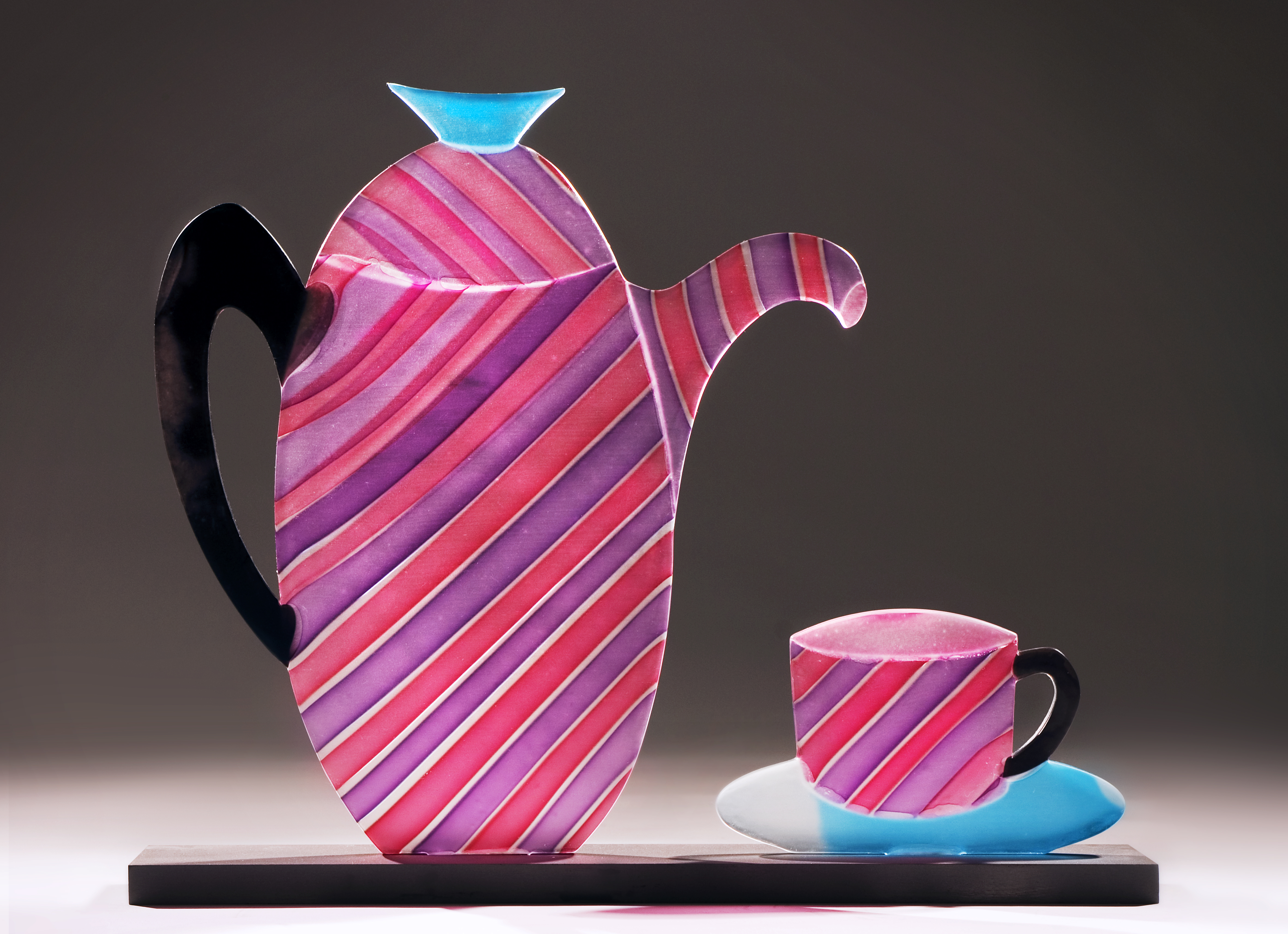
Jen: What’s the process you use when you think through a new line of work: do you start visualising what a work might be, or do you just sketch shapes and forms?
David: Most of the work that I call my serious work starts out as thumbnail sketches in my sketchbook. I start with a concept, and what I’m thinking about or what I’m alluding to in the sketches lets me know what I want to work on. A lot of the sketches show where I found the inspiration. The drawing with the big colourful squares was inspired by that book of quilts from Gee’s Bend:1 you can see the patchwork effect. At the time I was looking at the way the quiltmakers divide their space and manipulate images within the space. In the platter work it’s all about division of space, the same way a printer or painter or quiltmaker would look at division of space. I see the platters as a way to paint three-dimensionally.
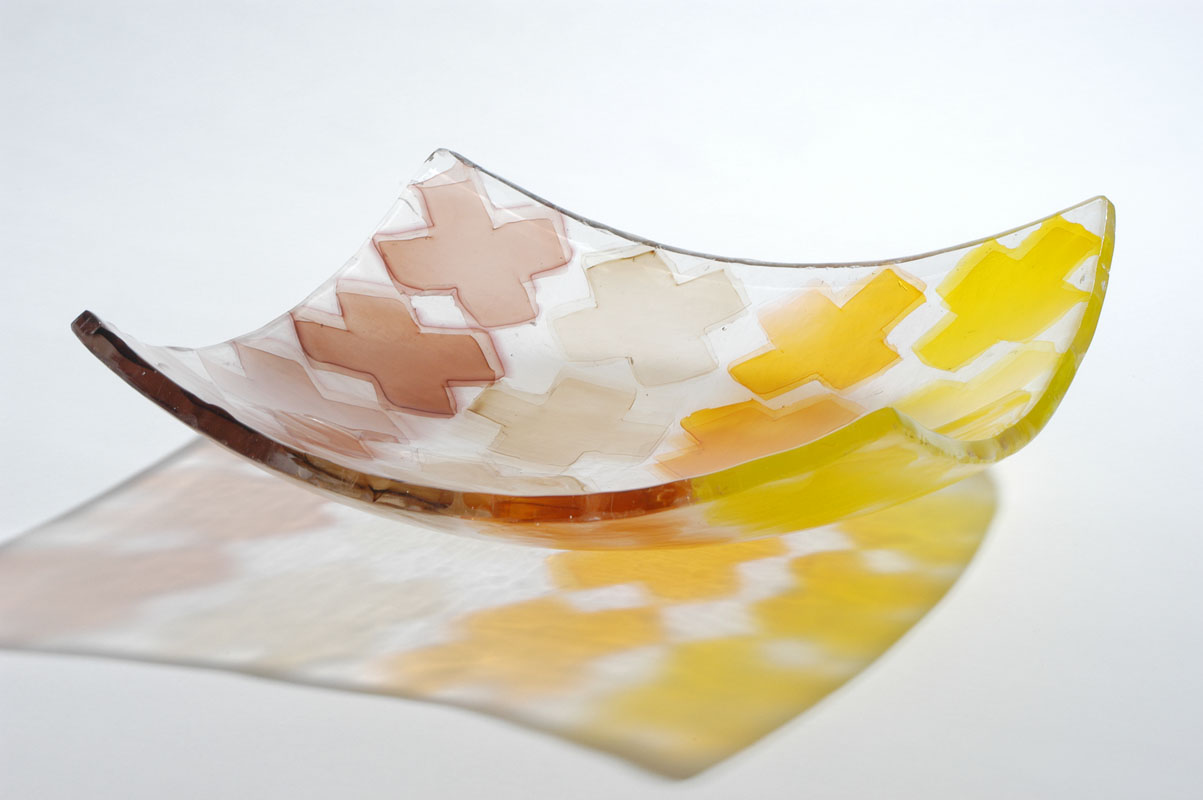
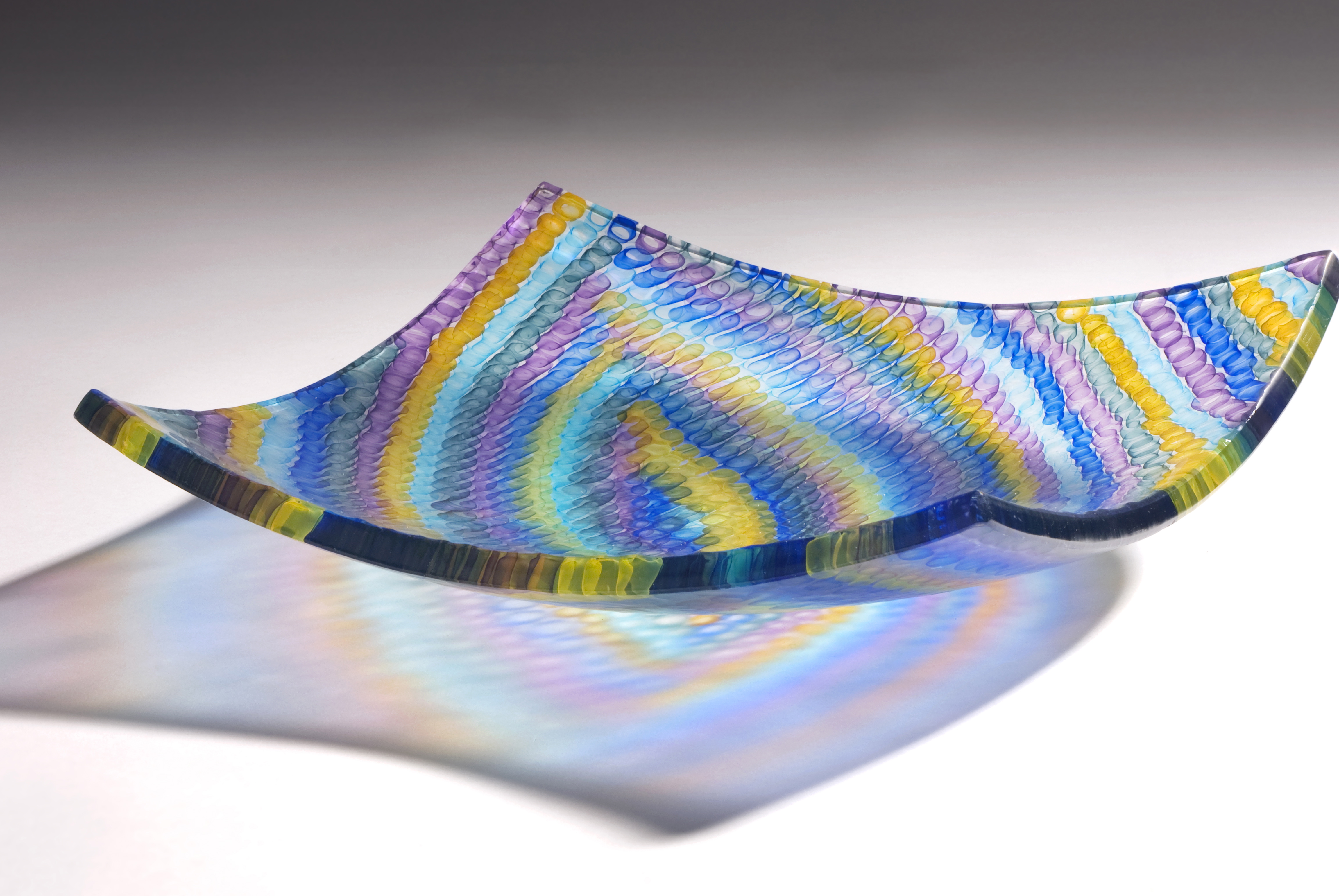
Other drawings might be elements of a still life, and some of the drawings relate to work by Ann Verdcourt, who’s a New Zealand ceramicist; and some are influenced by the Christchurch artist Marion Maguire, who is making gorgeous Grecian-type forms as an element of printmaking. My Illusions work—well, think of Oldenburg’s illusions, like his Giant Toothpaste Tube (1964).2 You can see that influence in some of the drawings.
Some of these drawings and ideas go back a long way. There’s an idea I’ve never done which I called Dreams of a Vessel. It’s in a sketchbook that goes back to when I was at university, in maybe 1972. What I was thinking about at the time was to make clear objects, and then cast a light on the object, draw around the shadow and make the shadow in a coloured element, and then display them together. I’ve never made it; and yet the elements of these Dreams, the dots and the lines, are in fact what I’ve been working on all this time. So there are themes that run through my head, right through my career.
Jen: What is it then that drives the next stage after you’ve had the idea and made the drawings: what means a drawing either becomes a work or doesn’t become a work?
David: What drives the next stage is a decision-making process, and the decision I make is based on this: during the next fragment of my life, I’ve got enough time to make how much work; I’ve got enough money to make how much work; and which of the ideas that are in front of me are the ones I’m most committed to? I use the drawings, because drawings don’t take a whole lot of time; they certainly don’t take money. So when I decide I’m going to commit $400 or $1000 to my next body of work, I have actually decided which of the ideas is the most successful idea. The bottom line is that if I could make work as quickly as I can think it, then I could do everything; but I can’t. If it takes me 40 hours to make a piece, then I have to know that the one that I’m making is the one that it will work: the one that’s resolved.
Jen: And what happens at that point, once you feel you’ve achieved the resolution?
David: When I’m working on an idea, I get to a point where I suddenly say to myself, What else can I say with this idea? That’s a natural point for me to say, I don’t want to make these any more. I’ve said everything I can with that idea. For instance: the first idea I had when I moved to Whanganui was to make baskets. Initially that happened because I was trying to think about the fact that I was now in a country where flax weaving was a major thing. I was looking at weaving and thinking about weaving, and then I got to the point where I did an exhibition of groups of baskets that hung on the wall. But before I got to that point, I slumped a bunch of glass rods, I drilled a piece of wood to put them in, I took copper wire and I wrapped it around, and built a basket out of copper wire, and then I filled it with clear glass globes. The basket was a metre wide by a metre tall. I took it to the Sarjeant Gallery,3 and some kid broke it while it was in the exhibition: he snapped one of the rods. I had snapped one of the rods too, putting the wire on it, because I wasn’t aware of how much tension I was putting on, so I had to replace that rod and then put it all back together again. That work’s completely broken now: it’s beyond repair.
It was a bit of an experiment, and it was the first time that I’d slumped glass so I had to figure out how to do it. I didn’t know what I was doing, technically; I only knew what I wanted to do, aesthetically. So aesthetically I had the idea, I did the drawings, I knew where I wanted to go, there was the Whanganui Open coming up and I wanted to be part of it, and I thought Well here’s this piece, it’s different from anything I’ve done before, but it’s something that relates to who I am today, being here, in this new country. And what I learned in doing the piece gave me the confidence to start slumping the baskets, and that gave me the confidence then to start slumping platters, so all of that technical linear progression has led me to where I am today.
Jen: So you needed all those steps along the way; and you needed to keep making, and making things differently, so that you could do other things. But when you start a new body of work—take the baskets, for instance—as you work through that over three years, is some of that time spent in figuring out the technique, working out how you can actually make your idea in glass?
David: Well, yes. Like I was saying, there was an element of technical experimentation, but that was really quite quick. I probably wouldn’t have spent more than two or three months figuring out the tactical ins and outs, and after that it was about getting on and doing the work and seeing how the work evolved and progressed. Progressing in size, form, colour … all sorts of things. The next thing I made was baskets that were table pieces, and then the next thing was the baskets became wall pieces. I’m guessing, in the three years or so, I probably made about 75. And then I got to a point where I felt that that body of work had ended, that I wasn’t doing anything new. As far as I was concerned I was just replicating what I’d already done. After three years of making baskets I thought, Well what more can I do with this? Nothing. I didn’t want to keep going: it’s just going back in time, and I think Well, if I’m going to spend $150 for furnace time, I’d rather be going forward into the future than back into the past.
Jen: You haven’t adopted the Māori concept of time as a spiral, then, where the past and the future are always there with you?4
David: Well, past and future are linked. There’s no question in my mind but that there’s a linear thread to my work. I couldn’t do the work I do today if I hadn’t done the work I did the year before, and the year before, and the year before, and the year before.
Now, the second thing I made after I got here was the Seven Sceptres of the Deadly Sins, which I still think as a group that didn’t work. Each of the individual pieces I thought was really a work of art. But it didn’t work as a group.
Jen: The look of them together didn’t give the right harmonies and juxtapositions. They just looked like a bunch of individual pieces you’d shoved together.
David: Exactly, and that was almost entirely because I had a concept, and then I made a piece, and what I learned about that piece allowed me to make changes when I made the next piece, and so on. By the time I got to the seventh one they had grown way out of proportion and every one of them had problems of balance, or of manufacture. Like, the first time I exhibited the Sceptre of Gluttony, which was full of Smarties, someone put too bright a light on it and the Smarties started to melt. With the Sceptre of Anger, my initial thought was to fill it with razor blades. But having bought $65 of razor blades and they only just covered the bottom I thought, I can’t afford to put $1000 worth of razor blades in it, so I found a guy here in town who’d make me bullets without any powder in them, but I’m not 100% certain that the mix of bullets and razor blades worked as well as the razor blades on their own. I mean the blades had—pardon the pun—a sharpness to them, an edge. [laughter] Another sceptre, Sloth, was my favourite, because for Sloth the globe was empty. The one I used money in, Greed: I put $55 worth of 5 cent pieces in, and of course that weighed a ton. The weight of the bowl was probably 5 kilos, and then someone picked it up by the stem, and it wasn’t designed to carry that much weight, so it broke. Pride didn’t work because it was in fact too tall: it was two metres high. The globe was full of peacock feathers, and the feathers worked, but the scale was too big: with the exception of one sceptre that they use to open Houses of Parliament, most sceptres are only about a metre and a bit, and when I looked at my sceptre I realized the proportions were wrong. So I had this idea, I put them together, I made them, I was quite happy with them, but I never sold one of them. They all ended up breaking, except for Gluttony which melted.
Jen: Clearly, sin is not your line. [laughter]
David: However, the process meant I made a bunch of smaller pieces, some wands, which did sell. So that part of it was about transfer of knowledge. They’re not serious works of art, but they’re slightly more serious than, say, making a domestic bowl.
On domestic ware as ‘serious work’
Jen: I was interested that you describe a piece of glass as not ‘serious work’. What for you constitutes a serious piece of glass, as opposed to a non-serious one?
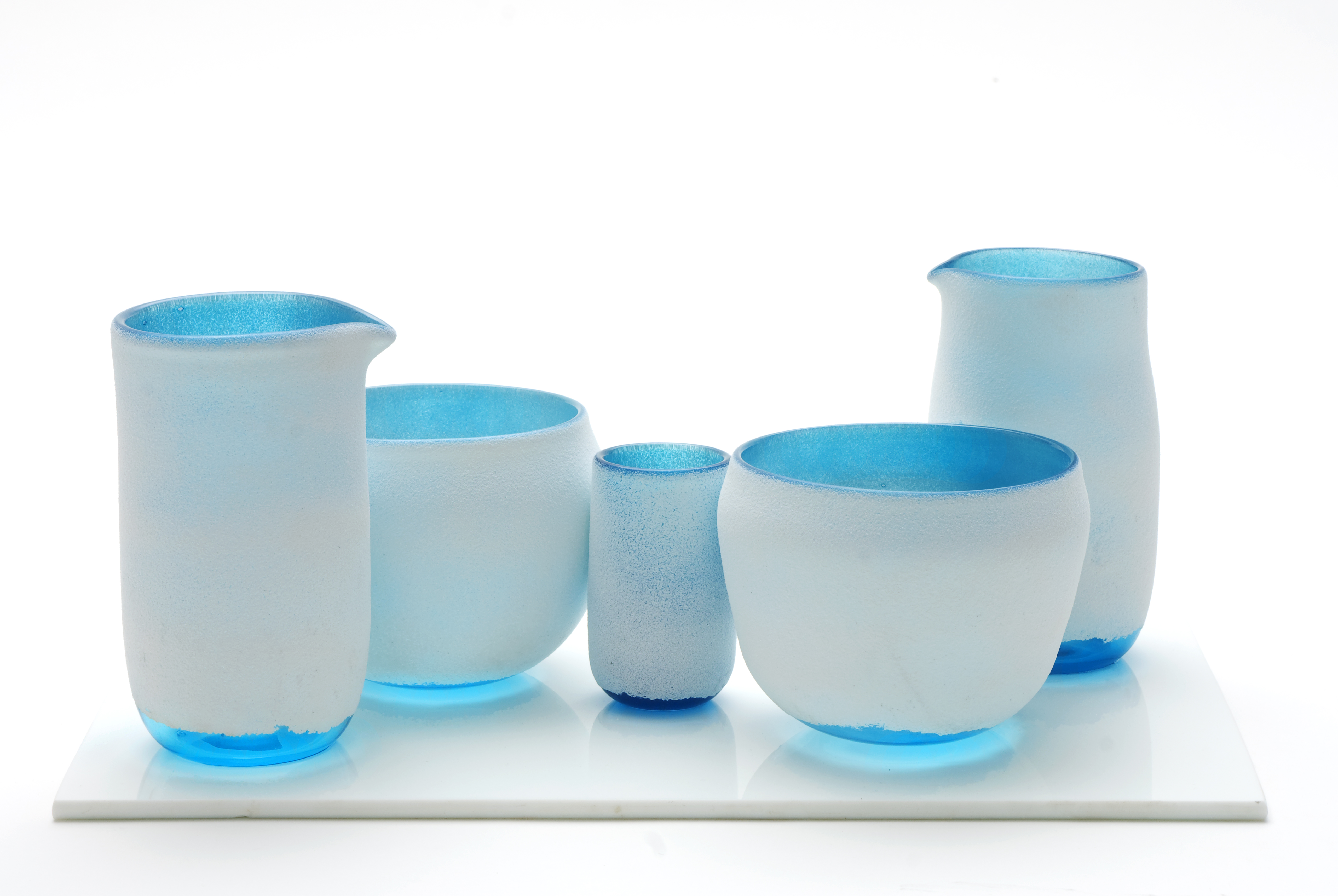
David: I think my serious work is work that has some underlying theme or element of discussion I want to have with the viewer. With my still lifes, for instance, I’m looking at groups of objects that are everyday objects, but presented in a way that challenges the viewer. So with my still lifes I’ve got a series of jugs that no one can pick up because they’re permanently attached to a base, so here I’m looking at the division of space, I’m looking at the relationship between those pieces, I’m looking at the fact that it’s also an everyday object, a domestic object. I think people can get their heads around the concept more easily because I’m not challenging them with something that looks like it came from outer space.
Jen: So you’re relying on the familiarity of the everyday vessel.
David: Yes; it helps draw the viewer in. So if the serious work is about work that has a theme, the non-serious work is about the transfer of knowledge within my process. So for instance, I know that I can go in to the studio and make a really nice bowl in maybe 20 minutes, and I can sell that bowl for $130. There’s no pretension that the bowl is anything other than a bowl. It’s an object to sit in my house or in someone else’s house, and put fruit in, or eat cereal out of.
Jen: In non-serious work, then, function becomes more important than form?
David: I don’t know that it becomes more important, but it becomes more accessible. People could choose to put fruit in my platters, but my suspicion is that they don’t because they’ve spent so much money on the platter that they want to look at it, not look at the fruit in it. But having said that, I used the platter form because it’s a domestic form, and my career has been rooted in the domestic.
Jen: Can you tell me a little more about your choice of domestic ware and domestic shapes?
David: I think it goes back to the beginning of my career as a glass artist, because I needed to make money. The domestic form was what I was trained do make at art school, and I thought well, okay, this is a starting point. When I originally started my career, I trained in ceramics; I was hand building pots, and working with clay in domestic forms. But when I got out of university and I saw somebody blow glass, the natural thing for me to do was to take the forms that I was making in clay, and try to do them in glass. I realised quite quickly that it worked for me because I could sell a bowl for $10, and back then $10 would cover the cost of my gas bill in my studio for half a day. So initially I did domestic work because I needed to eat and I wanted to make work. I was a designer-maker then; that’s where I started.
When I went to the Royal College of Art I’d been blowing glass for about 12 years, and from that point I started to think about it more from an artistic point of view than from a design point of view. I did a series of pieces where I was deconstructing the domestic, and I think that work, which I did on and off for maybe three years, gave me the freedom to go back to the domestic object, and utilise it as a part of a discussion that I wanted to have within my artwork.
Since then I’ve maintained both threads. I feel just as comfortable making a small vase or a bowl which I might sell for 50 bucks as I do making a large sculptural piece that I’ll sell for 4 or 5 grand.
Jen: And when you’re making that little bowl, do you feel you’re still dealing with the issue of themes in art work, or are you just generating a bit of income to cover the costs of the bigger works?
David: Well, the truth is that in the last half a dozen years, the pieces that I make like that, the little bowls, they tend to be experiments for my other work. So I might start with a drawing, and then think, Okay I’m going to go do that. Look at my still lifes, like the piece called Outpouring. There are nine jugs in that piece, but when I was making it I actually made 18 jugs. So I started with an idea; then I made 18 jugs; and I started playing with them. I tried different sizes, shapes and colours. Of the 18 that I made, 9 are permanently fixed in position, and sell as one piece, and they’re nonfunctional. But the other 9, they’re sold as individual pieces for $60 or $70, to someone who just wants a jug, or wants a little piece of glass.
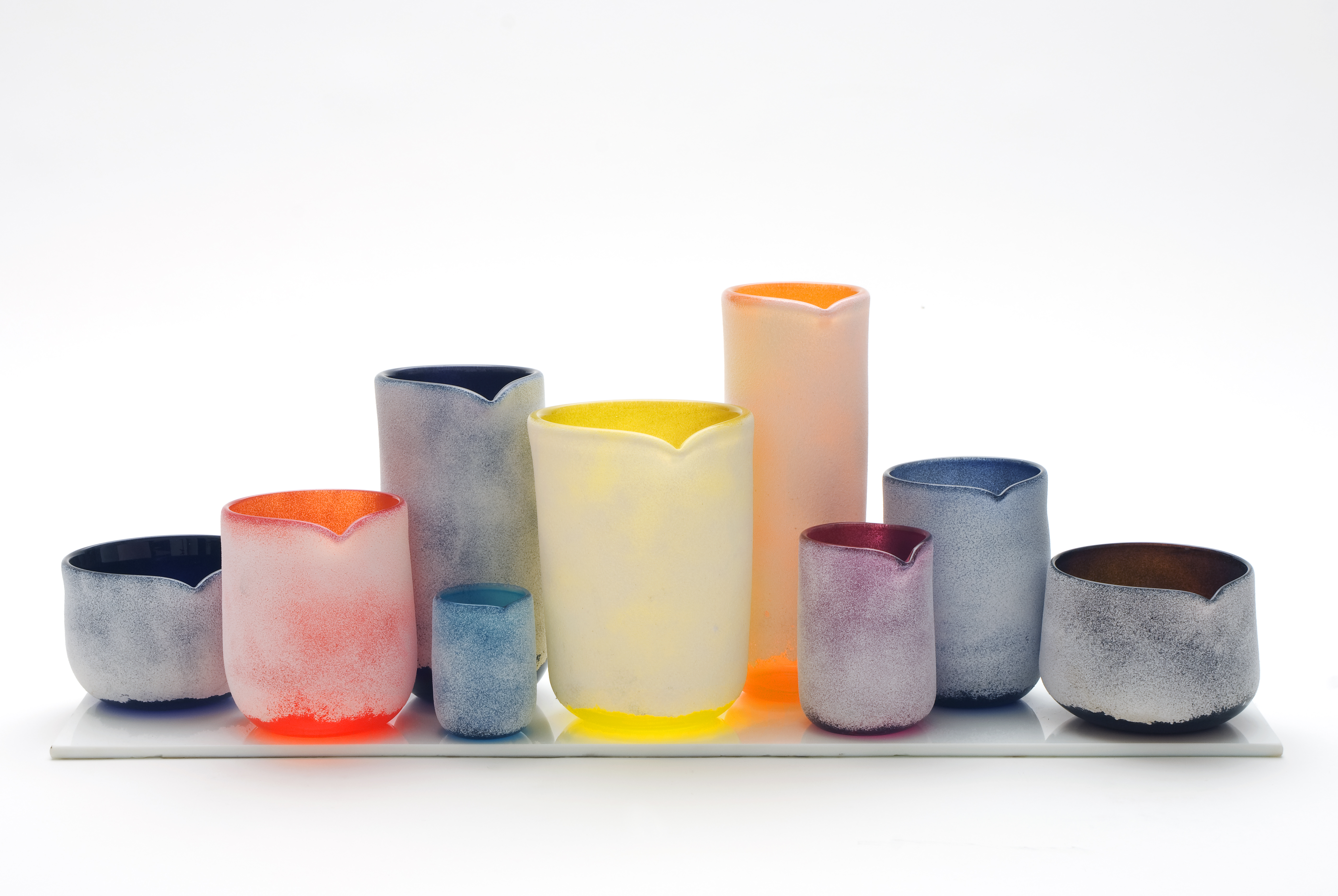
That tends to be the way I work these days. I don’t go into the studio and say, I just think I’ll turn out a few bowls. I tend to go into the studio and say, I have this idea for a piece, and I need some bowls for it. So then I make a bunch, look at them, assess them; make the work. What I don’t use for my discussion, those pieces I just sell as domestic pieces.
So, like I was saying, the first attempt that I had at making something other than domestic ware for the domestic market was when I went back to school at the Royal College of Art in 1984. At that point I started to look at and think about glass as a material for art, as opposed to a material for production. That was when I started to move away from being a designer-maker, and started to look more at being an artist-maker, if that’s the right terminology.
Jen: It’s interesting terminology; especially now, when so many designers present themselves as artists. But when you use the term ‘designer-maker’, are you thinking there about the utility of the object a person makes?
David: Well, I think so. To me that’s what a designer-maker is.
Jen: And how about technique: is technique more to the fore as a designer-maker than it is as an artist-maker? Or does the work of a designer-maker end with technique, while art adds that a level of idea, of conversation?
David: To me, art has a conversation and design has a function. That has always been what I’ve looked at. The British woodworker David Pye, who was head of the Furniture School at the Royal College in the 1970s, before I was there: he wrote a couple of books, and in one of them he talks about—I’m trying to remember his words—he talks about certainty versus uncertainty in terms of craftsmanship or workmanship.5 He talks about the fact that a machine-made object has no room for uncertainty; it is a machine and it doesn’t vary. But a craftsman has the ability to modify or alter in some way each piece. You might make a series of identical glasses, but they aren’t standardised. There’s that uncertainty there. If the making is by hand, you can have infinite variety, whereas if you’re pressing a button on a computer, and the computer is cutting identical components out, there is no variety. So a designer-maker is a person who designs and makes the object.
But the function of an artist, I’ve always felt, is to be in some way the conscience of the society they live in. So what the artist does is to take themes that are out there; they could be really big themes or they could be very minute themes; they could be about war and peace, or they could be about how we live our lives. We take a look at what’s out there, and we represent it within our work. And I don’t believe that a craftsman who is making a series of domestic objects for domestic use takes those considerations to heart.
Jen: Because they’ve got to be focusing on the use of those objects, and having them standardised sufficiently so that they’re easy to use, and familiar?
David: Yes, function becomes more important than content. Now, one of the advantages that I have with glass—and I guess this goes back to the beginning of this conversation, and serious versus non-serious—is that I’m able to use a series of processes that fall on either side of that argument. I can make objects which are serious, i.e., have some sort of dialogue that I want the viewer to have with the piece, or I can make pieces that function within the domestic world.
On glass
Jen: What does glass give you that clay doesn’t, or didn’t?
David: Umm. I’d have to say initially I was intrigued with glass for two reasons. One is that it’s linear in its thought process. The way a glass blower works, and the way I liked to work when I was 20 years old was I’d blow a piece and put it in the annealing oven, I’d blow another piece and put it in the annealing oven, I’d blow the next piece and put it in the annealing oven. When they came out of the annealing oven I’d have a little bit of finishing to do, then sign them, price them and sell them.
The way a ceramicist works is: I throw 150 bowls; the next day, I trim 150 bowls; the next day I bisque fire 150 bowls; the next day I glaze 150 bowls; then I fire 150 bowls. By the end of the week I’d have about the same amount of work, probably about the same retail value, but the thing is, I’ve had to think about 150 pieces at once.
Jen: Which means with clay you’ve had to go again and again on the same pieces, just using different processes. And with glass you finish the unit, and you know what you’ve done with it; then you can take that knowledge to the next piece.
David: Yes. So there was that element of it. And the other element was obviously the fact that in the 1970s in America and in the 1970s in New Zealand you’d be hard pressed to find a street corner without a ceramicist on it, [laughter] but glassmakers were practically nonexistent. So it was hard for me to see how I was going to have a point of difference between my clay work and every other clay person’s work. Whereas because glass making was so new and there were so few of us, it was much easier to come up with a point of difference.
The first couple of years, my point of difference was the fact that I could do the process. I wasn’t very good at it, but I could do it. About four or five years into it I started designing things and playing with colour, and at this stage my point of difference was the way I used colour. Like, I did a series that was all domestic work, but I designed it. There was a series where I would take lots of little threads of colour and I’d break them up into tiny little bits of colour, you know, like the coloured sprinkles you dip an ice-cream cone in. I would blow these bowls with white glass on the inside, then I’d roll it through the sprinkles and pick up a band of colour. I called it my French Impressionist Rip-off Series, because they looked like pointillism, and so that was my point of difference. Then I had another series which I called my Oriental series. What I tried to do was, I made this bowl, then I took a colour dot and wrapped it around the piece, so it was a blob of colour that went into a tail, that went around and stopped before it got back to itself again. And whatever that colour was, I also put that colour on the lip of the piece. That was the first piece I did, and I looked at it, and I thought yes, that’s interesting. So I tried to do another one, and as I was doing the next one the glass got a bit cold, and the blob broke, and so now I’ve got a dot and a trail, and that looked much more Oriental than what I had done the first time. Those pieces were a staple of mine for a number of years.
What I used to do with my work when I was being a designer-maker was I would try to maintain six or seven design ideas at once. They were mostly different applications of colour and decoration, combined with form. And then every year what I would do was I’d find one new idea, and then take one of those ideas that I was making and put it away.
Jen: So you were looking for continuity and change?
David: Yes, and so that I was able to say, after three or four years, ‘No I’m sorry, the French Impressionist Rip-Off series doesn’t exist any more’.
Jen: Like a printer breaking the plates? So they become more clearly collectors’ pieces because they’re a limited edition.
David: Yes. But from 1980 through 1995 when I moved to New Zealand, in those 14 years I probably would have made in excess of 6,000 to 7,000 pieces of glass a year. When I was teaching, I was only teaching two days a week, and my summers I would spend in America doing production work. So a summer for me meant a minimum 2,000 pieces of glass: we’re only talking about basically good designed domestic work. In the last six or seven years, I’ve probably only made maybe 120 pieces, 130 pieces a year, but that’s in part because I spend approximately 40 hours making a platter.
Jen: So that’s another difference between art and design work: the volume and speed of output.
David: Exactly.
Jen: Given how many pieces you have made, do you still recognise your work?
David: Some, yeah. Because I had those distinctive design features. Also, with the exception of the work I made the first six months, everything I made since then has been marked. When I was learning my trade, I knew nothing about glass making, and so the work that I made during those six months is not signed. But since then it’s all signed. Over the years I’ve probably made 25,000 or 30,000 pieces of glass, so I don’t remember every piece I’ve made, but if it’s got my signature, it must be my piece. Over the years people have written to me and said ‘Are you the David Traub who made this?’ and they’ll send me an image of a piece of glass that I made in the 1970s or 1980s, and it has my signature on it. So they’re still circulating.
I’ll tell you a funny story. My brother moved to Texas in 1980, so I’d been blowing glass for seven years, and he moved in with a girl. The first time I went over to see him, I walked into her house and went into the living room, and over there on the television was this really beautiful piece of glass. I went over and looked at it, and thought Some day I’ll be able to do one like that. So she comes back in the room, I’m introduced to her, I said to her, ‘Where did you get this? It’s really beautiful’, and she said, ‘Oh I bought it from a glass artist out in Edom’. It was one of my pieces that I’d never signed, and I didn’t recognise it. [laughter] It had to have been one of the pieces I made during those first six months, and it probably was the only piece I made during those six months that was really beautiful.
Jen: You always had high aspirations for your work: you identified the really good glass early on.
David: Yes—they were pieces made by people whose work I really admired, and I aspired to get to that level some day. The work that I was selling for $20, I always explained to people, ‘Look I’m still learning, and the work you’re buying is reasonably priced, good quality glass’; but some day I hoped to be better.
There’s another funny story I’ll tell you. There’s a process in blowing called the graal. It’s a process that was invented in Sweden in about the 1940s. The basis of the process is you make a blank, and on the outside of the blank you put a thin skin of colour, and then you cool the blank down, and then you sandblast the design in it, removing the colour from part of it and not from other parts. Then you take the blank and you put it back in the kiln, heat it up, pick it back up on the blowing iron, put another layer of glass on the outside of it, and then you blow it to full scale. And as you blow, whatever design and colour that was on the blank is now writ large. Okay, so I learned the process in 1980 at Pilchuck,6 and I was quite intrigued with the process. I made about six pieces while I was at Pilchuck, and one of them was a vase form that was an opaque grey glass. The design was a square of grey and a circle of clear, and then a square of clear and a circle of grey. I really liked that piece, so I took it home with me.
The first craft fair that I went to, I tried selling that piece for $75. Everything else on my stand was $25 or less, and some guy walked up and looked at that piece and said, ‘Why is that one so expensive?’ So I explained the process to him; and part of selling to the public in those days was educating them what glass was about, because they didn’t know. So we argued about it for a while, he offered me $50 and I said no, it’s $75, and in the end he walked away. But the process of educating him and talking him through it made me realise it was the most significant piece of glass I’d made to that point, and $75 was really too cheap. [laughter] So I took the price tag off and put $100 on it, and a couple of hours later he came back and said, ‘Would you take $65?’ and I said, ‘No, in explaining it to you, I realised it that $75 was too cheap, I’ve raised the price to $100’. He said, ‘Well, what if I were to give you $75?’ and I said ‘No, I’ve won’t take any less than $100’. Well, he didn’t buy it; and every six months that the piece didn’t sell I became more and more convinced that it was a serious and important piece of glass, and I raised the price by $50. The day I put $400 on it, it sold.
Jen: I often wonder about the relationship between price and implied value: that an audience can see it and say, ‘Well, it must be good, otherwise he wouldn’t be asking that much for it’.
David: But you know, the town I lived in was a farming village of 200 people. Not one of the people who lived in that town ever bought a piece of glass from me. I started blowing glass there in 1973; in 1984 I moved to England; from 1985 through 1995 I lived in England and I came back to do craft fairs in America. Well, I think it was 1992, Dale Chihuly had an exhibition in the Dallas Museum of Fine Art, and when I did the craft fair that year all the locals came to visit me and most of them bought something from me. They’d all understood what glass meant because when they went through the Chihuly exhibition with their friends, they were able to tell their friends, ‘Oh yeah, we know how this was made because we used to watch this guy who used to live in town and who did that’.
Jen: So there was a sense of connection, of familiarity—or a literacy? And I guess too it became valuable to them to have a piece of your work to prove that they know what they’re talking about.
David: Absolutely.
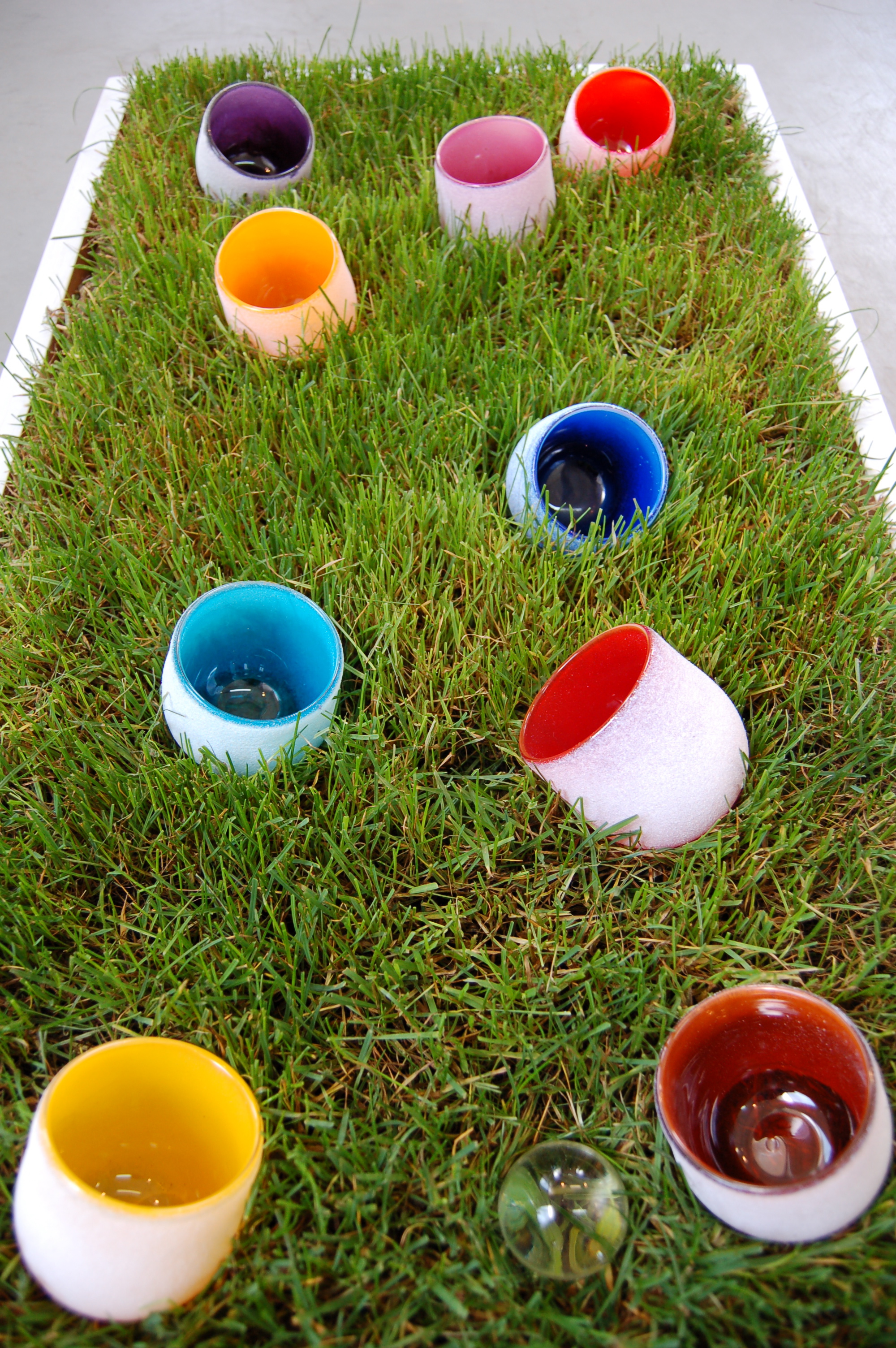
On colour
Jen: Let’s talk about colour. To me, your work seems extremely painterly. I think here of the Chromophilia exhibition you and Lorraine had in 2009, that combination of glass art and paintings.7 You and Lorraine were quoted back then to the effect that ‘colour’s infinite variety, perceptual complexity and beauty can itself be the foundation of serious endeavour’. You’ve talked too about being informed by painters and quilters, and your work does seem to use colour in a way that isn’t, to my eye, typical of most glass artists whose work I’ve seen.
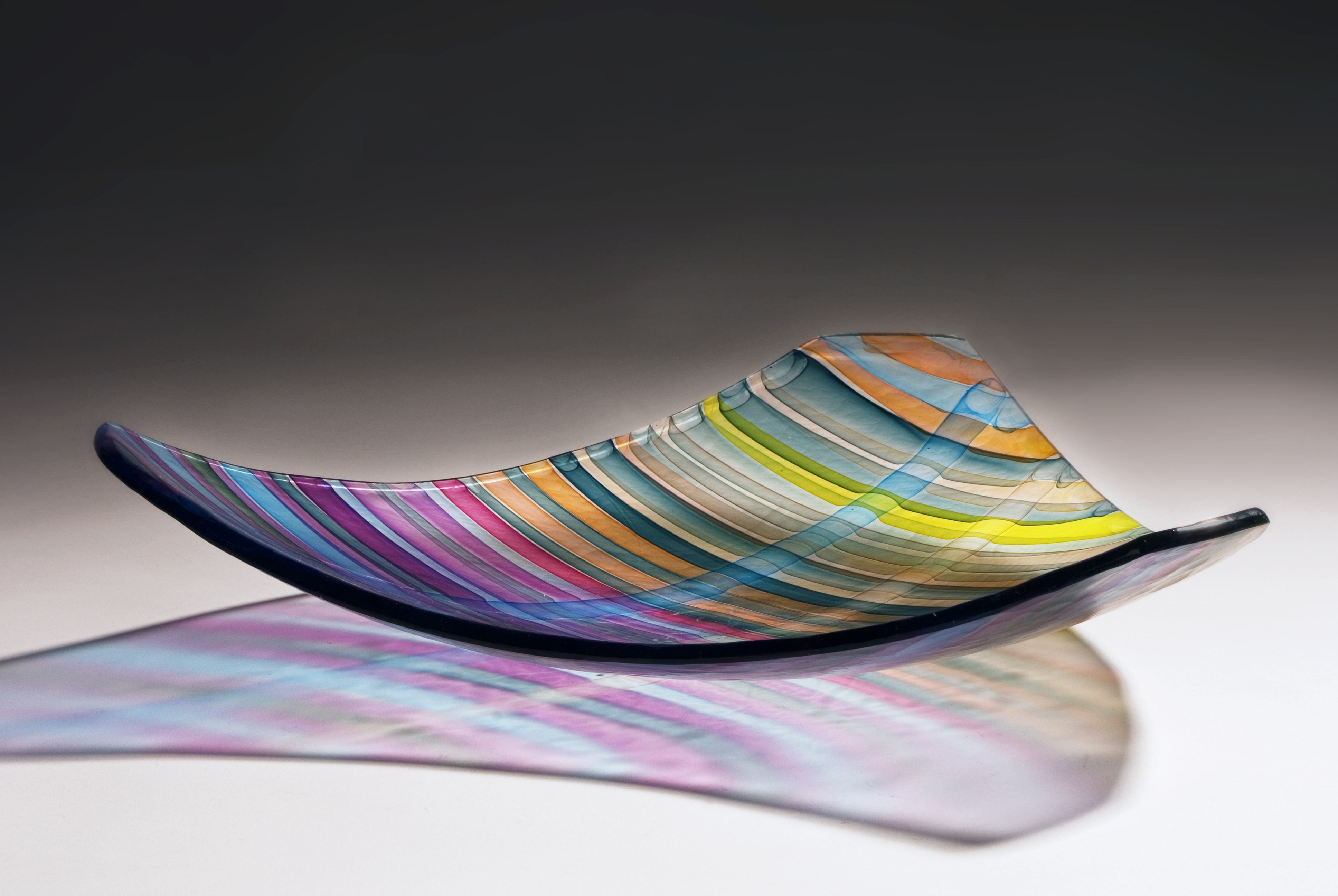
David: Chromophilia was a nice exhibition, where Lorraine was doing work with dots and stripes, I was doing work with dots and stripes, and it worked well together. I think for me, since I started using colour—which would have been about 1978—it’s become a really important aspect of what I do. I guess it’s because I probably see myself as a frustrated wannabe painter.8 I was never good at painting, but most of my heroes in the art world are painters: Jasper Johns, Morris Louis, Jackson Pollack, Mark Rothko … I mean, most of the colour field painters from the 1960s and early 1970s are people whose work I really like. And at various times in my career I have looked to different people’s work and tried to interpret it.
I’ve interpreted Morris Louis’ work on numerous occasions. The first one I did, I was visiting a friend’s studio in Oklahoma, and I did a demonstration for his students. I did a vase that had stripes of coloured glass on a white base in the style of Morris Louis, and the piece was so successful that I refused to sell it; it’s still somewhere in this house. Four or five years later, I did a little vase that had a similar feel to a different Morris Louis painting. And periodically throughout my career I’ve interpreted the works of painters whose work that I like.
Jen: As a homage? Like, the ‘after Rothko’ approach?
David: Yes, sometimes. There’s a platter at the studio that’s based on Ian Scott’s work and I call it ‘After Scott’.
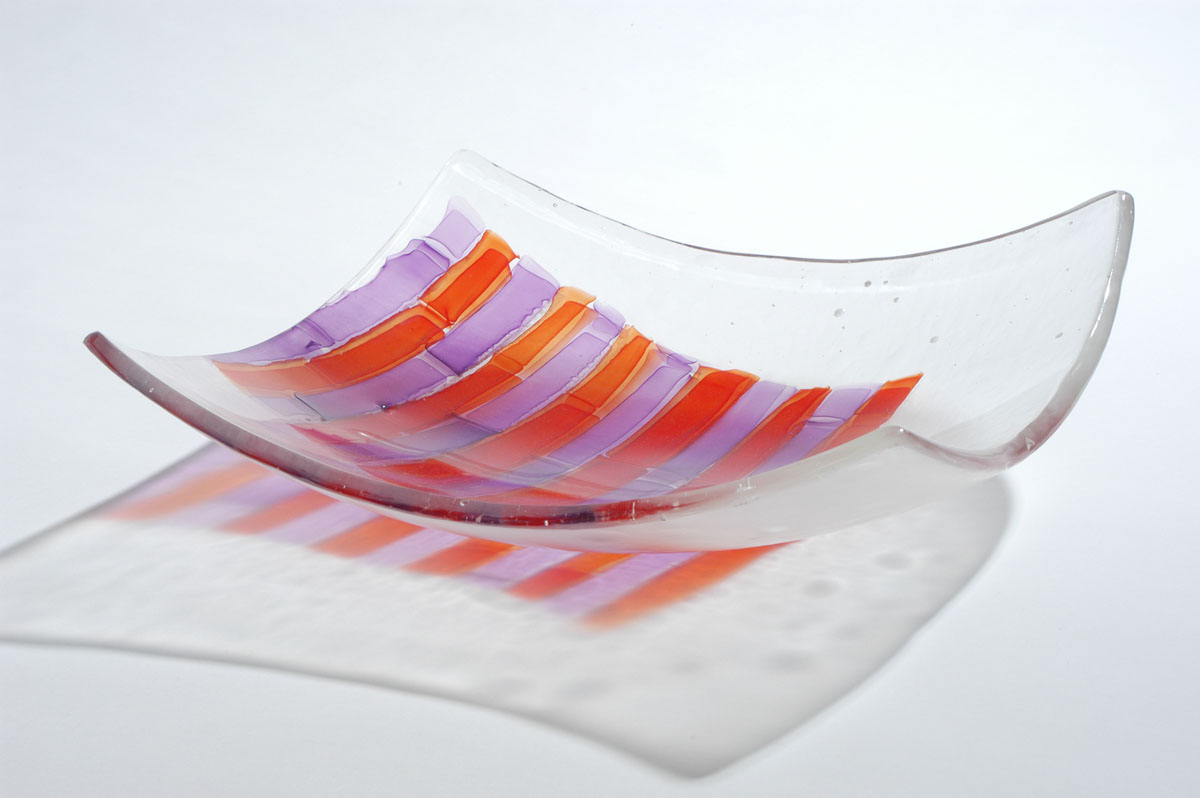
I saw a drawing of Scott’s in a gallery in Auckland; the drawing was a large piece of paper, and it was quite a bright, colourful thing, with the colour in just one corner, and the paper was quite white. I didn’t look at how he used colours, and I didn’t look at where he put his colours, but that idea of a piece of colour intruding on a space that was non-coloured: that what I was thinking about. So I’ve done that with one of the platters. I’ve got another platter out there that I call ‘After Rothko’; another one that I call ‘After Johns’. It’s because I’ve looked at these guys’ works over the years, and what I’ve tried to do is take their sense of balance and proportion and apply it to a body of work which is different from theirs.
Like I say, I’m not trying to copy their work, but it’s definitely inspired by their work. So I do look to painters, and I think my work and my use of colour is very painterly. And it’s not by coincidence; Lorraine and I have influenced each other. That I think is in part her living with me, and beginning to think in dots and stripes and colour; and my work, in terms of its formal aspects and the formal composition—the space it sits in, and how I manage that space—those are things that I think have been strongly influenced by my living with her.
Jen: Do you think consciously in terms of colour theory or do you work more intuitively?
David: No; it’s more intuitive. I have read colour theory a little bit, but I tend not to think about it. I guess one of the ways that I work similar to a painter is that I’ve never been good with chemistry. If you look at New Zealand glass making pre-1995, everybody who did hot glass in NZ made their own colour; it was just too expensive to ship it out from Germany. But two of glass makers, John Croucher and John Leggott, made such a wide range of colour that they set up a company making colour bar for glass—Gaffer Glass. So like a painter I pick up the phone and I call the supply house. I’m not making my own colours.
I have developed ways where I can get colours that Gaffer doesn’t make. I will apply one colour on top of another, and that looks as good to me with glass as it does for a painter who mixes two colours to get a third colour. I’m quite happy with that style of working. And I have colour I brought with me when I moved here from Europe. But there are things you have to know about the companies that make the colour. The oldest of the colour bar companies, their colours are slightly more intense than the other three, but they’re not as uniform in their make-up and so the extreme ends of their colour range I can’t use because they break. They’re physically not compatible with the glass I’m using.
I don’t want to bore you with the chemistry of it, but coefficient of expansion is a linear number assigned to a piece of colour that tells you about how it cools and expands and contracts, and you need two glasses that have similar coefficient of expansion to be compatible. With Gaffer glass, the coefficient of expansion is 96. Kugler Glass, which is a German colour bar company, is between 92 and 98 depending on the colour. Wiesenthal, which is another German company, for a time they used to print right on the label what the coefficient of their colour was. I brought some colour bar with me from Weisenthal, and it says right on the bar, ‘coefficient of expansion 96’ which means I know it’s compatible with our glass. Gaffer doesn’t make that colour, so I’m making these pieces that have a steel blue colour that no one else in New Zealand can make.
Jen: How you actually do it—do you put chunks of colour in the clear glass and dye it?
David: No no, it’s a thin veneer on the inside. So what I do is, I take a bar of glass, cut it on a diamond saw so there are pieces about an inch in length, then I preheat them, pick them up on the nose of the iron, melt them, and blow a little bubble. I let that cool, put a layer of clear on the outside, and blow the bubble bigger; put another layer of clear on the outside, blow the bubble bigger. Doing that, what happens every time you blow the bubble bigger is that the veneer on the inside gets thinner. If you were to break that piece of glass, you’d find a very thin veneer of electric green on the inside, but it actually looks as though the whole thing is electric green glass.
The process of doing colour that way is something that goes back before the idea of studio glass. There are two ways to introduce colour into a work. One is, you can do it that way, the veneer approach. Colour bar can be stretched, blown, made into thin rods, made into powders, made into frit, applied a variety of ways, but you’re still using colour bar. The other way to do it, which is the more expensive way, is that you have a pot of glass for each colour. If I didn’t want to use bars, I would have a pot of red glass, and what I’d do would be gather a little bit of red glass, blow a bubble, and then put clear glass over the outside. It’s still a veneer, but it’s a veneer done hot. It’s a much more expensive way to do it, because if you want to do a range of objects that require say 10 different colours, then you’ve got 10 different furnaces going, and each furnace costs $100 a day to run. Whereas the way I’m doing it is, I’ve got one furnace, it’s got clear glass in, and I’m buying the colour I want in the frit, rod, powder or bar that I want to use it in. So it’s an economy of cost.
Jen: I watched you starting to make a platter at the studio a couple of years ago, and you were using rods of colour that you were cutting into little pieces. I didn’t look at it closely; was that glass you’d blown with a veneer of colour or was it bars of solid colour?
David: It’s got a veneer. What I do is, I make those rods just like I’m going to blow an object; so I pick up a bit of colour, put a bubble in it, put a layer of clear over that, blow the bubble a bit, put some more clear on it, blow the bubble some more. Then I take that bubble and stretch it, and when I stretch it I open up the far end, so now I’ve got a tube of glass that’s got a veneer of colour on the inside, and two thin layers of clear on the outside. I stick that back in the furnace and I suck hot glass up the middle so it becomes solid, but it still has the ring of colour almost to the outside. If I chop them and lay them down, I get a line of colour, and if I chop them and stand them up, I get a dot. That process is called snorkeling, and I would guess I’m the most experienced glass snorkelling person in the world today because I use the process a lot.
The platters I do—there was a series of eight pieces I made in maybe 2005 for a show called The Nature of Colour.
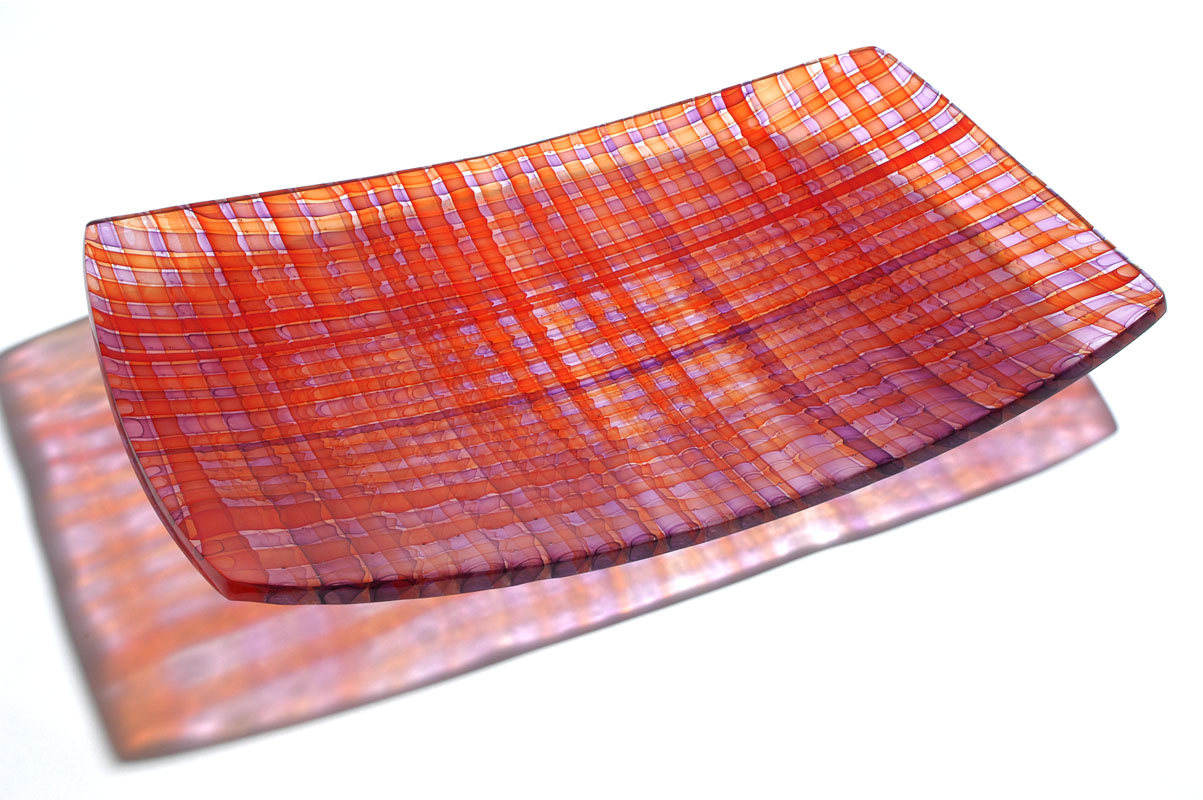
They were really big platters, 600cm long by 350cm wide but only about a centimetre thin, and they were slumped gently, so they formed big open dishes. Those platters took 72 rods each, so that particular exhibition took me 640 rods; and it takes me fifteen minutes a piece to make a rod by myself.
Jen: That’s pretty labour-intensive.
David: Well, even the smaller ones have 32 rods, and that’s eight hours of my time just making the rods. I go into the studio, make eight hours worth of rods, then once I’ve got those I go back to the studio and start cutting it up and assembling it; and that might take another seven or eight hours a piece. Then I fuse it, then it comes out of the kiln and I have to clean the edges and the back, and that might take another seven or eight hours. So it’s 26 hours and the piece is just going into the kiln to be slumped. Then I have to cut the back of it, and that can take another six or seven hours; so a simple piece is going to take me 30 hours.
So they are labour intensive, but it happens to be where I am at the moment. That’s one reason why I guess I’m quite happy to show anyone any time what I do: because my work is labour intensive; and someone who understands the process as much as I do still would not put together the same colours in the same way that I do it, so I’m not afraid that someone is going to steal my ideas and start making my work. There’s a quote that I used to use when I was teaching, and I’m sure I’m not giving it verbatim, but Picasso once said that if someone steals his idea and does it better than him, he doesn’t want to mention it because he doesn’t want to bring attention to it; and if someone steals his idea and does it worse than him, he doesn’t want to mention it because he doesn’t want to bring attention to it. You just have to keep doing your own work in your own way
- 1. Gee’s Bend is an African-American community in Alabama, USA, where local women have produced art out of necessity. See William Arnett, Alvia Wardlaw, Jane Livingston and John Beardsley 2002 The quilts of Gee’s Bend, Atlanta: Tinwood Books.
- 2. See Claes Oldenburg 1971 Notes in hand, Boston: EP Dutton.
- 3. The Sarjeant Gallery is Whanganui’s public art gallery. See http://www.sarjeant.org.nz/site/index.php
- 4. For a discussion of the spiral nature of time in traditional Māori epistemology, see Les R Tumoana Williams and Manuka Henare 2009 ‘The double spiral and ways of knowing’, Mai Review 3: Target Article 3, at http://www.review.mai.ac.nz/. The authors compare pragmatic and scientific ways of knowing with the traditional Māori way, and identify the heart of the latter as ‘the enduring relationship of the source of life force (mauri) to its manifestation in reality’ (2009: 3), on ‘a time scale that cycles continuously from the beginning to an end and back again’ (2009: 6).
- 5. Referring to craftsmanship, Pye writes that it is a form of making ‘in which the quality of the result is not predetermined, but depends on the judgement, dexterity and care which the maker exercises as he works. The essential idea is that the quality of the result is continually at risk during the process of making … With the workmanship of risk we may contrast the workmanship of certainty, always to be found in quantity production, and found in its pure state in full automation. In workmanship of this sort the quality of the result is exactly predetermined before a single saleable thing is made’. See David Pye 1968 The nature and art of workmanship, Cambridge: Cambridge UP (p.4).
- 6. Pilchuck Glass School, in the state of Washington, was founded in 1971 by glass artists Dale Chihuly, Anne Gould Hauberg and John H Hauberg. See http://www.pilchuck.com/about_us/about_overview.aspx
- 7. David Traub and Lorraine Webb, Chromophilia, shown at the WHMilbank Gallery, Taupo Quay in Whanganui, June 2009.
- 8. See David Traub’s ‘Painting with light’, http://www.glass-newzealand.co.nz/